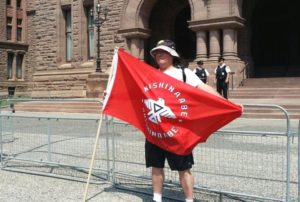Grassy Narrows is not alone

By Barb Nahwegahbow
TORONTO—Prominent labour, social justice, and environmental leaders portaged a canoe through downtown Toronto on July 7, 2016, in support of Grassy Narrows First Nation. Their destination was Queen’s Park where they were delivering a canoe full of letter and petitions to Premier Kathleen Wynne representing over 35,000 people.
“Grassy Narrows is not alone in demanding that Premier Wynne clean up their poisoned water system,” said Rachel Plotkin, Ontario Science Projects Manager of the David Suzuki Foundation. “We believe that the science exists to clean up the watershed so that the people in Grassy Narrows can eat the fish and continue their traditional way of life once again. The David Suzuki Foundation stands in solidarity with Grassy Narrows!”
Over 50 years ago, 9,000 kilograms of toxic mercury waste was dumped by the Dryden Chemical Company into the waterway that provided fish and water and an economic base for Grassy Narrows residents. The Ontario government has done nothing to clean up the river. Citizens of Grassy Narrows suffer the effects of mercury poisoning. A recent report by three renowned scientists said the mercury can be cleaned, and the water and fish made safe for consumption.
The July 7 canoe portage was organized by Leadnow. Other groups involved in the day’s action included: the Canadian Labour Congress, the Council of Canadians, CUPE, Free Grassy, and Amnesty International.
Marie Clarke Walker, Executive Vice President of the Canadian Labour Congress, told those gathered at Queen’s Park that Grassy Narrows and other Indigenous communities were victims of environmental racism. “What’s happening in Grassy Narrows would not be happening in any of our communities,” Walker said. “It’s very, very clear from my perspective, that race is a definite issue in all of this.”
“I’m here today to let everyone know,” said Walker, “that the Canadian Labour Congress and its over 3.5 million members stand in solidarity with Grassy Narrows.”
Dawn Bellerose, citizen of Thessalon First Nation said, “I just joined this fight about a year ago and I’m already frustrated. I can’t imagine how the people from Grassy feel.” Bellerose is the Aboriginal representative on the Board of Directors of CUPE, Canada’s largest union with over 635,000 members across the country.
Reconciliation and renewed relationships are words that are being tossed around by the government, Bellerose said, but what do they really mean. It’s time the government took action, she said. CUPE stands with the people of Grassy, Bellerose said. “It’s a good fight.”
Mark Calzavara from the Council of Canadians said Premier Wynne has a decision to make. “Is she going to act for Grassy Narrows First Nation and fulfill our responsibilities as treaty partners, or is she going to become the new face of colonialism in Canada?”
A citizen of Serpent River First Nation, John Oskaboose Jacobs, was flying the Anishinaabe flag in support of Grassy Narrows. “I started supporting them the last 3 or 4 years,” he said. “I’d tell Canadians to sign the petition, get hold of their MPP and let them know Grassy Narrows should be cleaned up,” Jacobs said.
Anne Couchie, citizen of Nipissing First Nation and a member of the Toronto Indigenous community, was part of the gathering at Queen’s Park. “I’m here trying to help Grassy Narrows,” she said in an interview. You have to be politically active, Couchie said, “and it’s better to do something than not do anything.” Couchie issued an invitation to all Canadians, “Join us and we’ll all make the country better.”
Premier Wynne was not available to take delivery of the letters and petitions.


